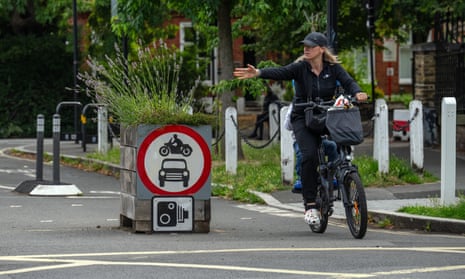It should be a no-brainer. In a country where 63.8% of adults are overweight, millions of people do not take the minimum amount of recommended exercise, and air pollution is a serious risk to health, encouraging walking and cycling rather than driving short distances is good public policy. All over the world, but particularly in rich, western countries such as the UK, where populations are ageing and healthcare costs are rising, boosting public health and preventing illness should be aims shared by all. As well as their local impacts, cars are a big contributor to global heating and in 2021 were responsible for 57% of the UK’s transport emissions.
But ever since the Conservatives pulled off a narrow victory in last year’s Uxbridge and South Ruislip byelection, aided to some degree by their opposition to the expansion of Sadiq Khan’s ultra-low emissions zone (Ulez), Rishi Sunak’s government has performed an about-turn. A preference for private over public transport has long been a feature of rightwing politics. But under Boris Johnson, a combination of public health and climate goals convinced the party to back schemes aimed at discouraging unnecessary driving. In 2020, ministers made new funding available for low-traffic neighbourhoods (LTNs) because of the need for safe alternatives to trains and buses during the pandemic. In London, an unprecedented expansion led to 300,000 people finding themselves living in an LTN within six months.
Not every scheme worked. In some places, implementation was rushed and preparation inadequate. As with other new systems, perhaps especially ones that rely on behavioural nudges, transport arrangements need to be tried out. But the vast majority of projects launched four years ago are still in place, and three pieces of new research reveal the shocking extent of the government’s error in setting its face against cleaner, healthier cities – in favour of an irresponsible pledge to ditch “anti-car measures”.
One study commissioned by Mr Sunak himself, and buried before being leaked to the Guardian, showed that LTNs in Birmingham, York, Wigan and London had an average of 45% support and 21% opposition – putting to rest the myth of their unpopularity. Meanwhile, an investigation led by Prof Rachel Aldred showed that average walking and cycling levels increased substantially in three London boroughs where LTNs were introduced. The third report, on London’s air quality, reveals that roadside pollutant levels have fallen dramatically since the Ulez was introduced – offering a boost to Mr Khan before May’s mayoral election.
Already, some European cities are streets ahead of the UK in their ambitions for pedestrianisation. But a recent upsurge in antipathy to the concept of “15-minute cities” – where people spend more time where they live and less time commuting – has tipped into paranoia in some quarters. Ministers should have known better than to legitimise such fears. In stoking hostility towards Labour-run councils that are trying to make cities healthier and more habitable, Mr Sunak has set his country back.
The reality is that ubiquitous satellite navigation has undermined decades of urban planning – by directing traffic down roads not built for it. LTNs, along with other clean air measures, are part of the solution to pollution and congestion and the harm caused by sedentary lifestyles and unhealthy diets. Judging by the evidence, and to the credit of the councils that run them, they are succeeding.
